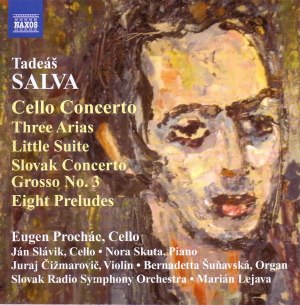 |
 |
|


alternatively
CD: MDT
AmazonUK
AmazonUS
Sound
Samples & Downloads |
Tadeás SALVA
(1937-1995)
Concerto for Cello and Chamber Orchestra (1967) [11:57]
Three Arias for Cello and Piano (1990) [13:40]
Little Suite for Cello and Piano (1989) [9:03]
Slovak Concerto Grosso No. 3, for Violin, Cello and Organ (1987)
[20:30]
Eight Preludes for Two Cellos (1995) [17:20]
 Eugen Prochác (cello)
Eugen Prochác (cello)
Nora Skuta (piano), Bernadette Šuňavská (organ),
Juraj Čižmarovič (violin), Ján Slávík
(cello); members of the Slovak Radio Symphony Orchestra/Marián
Lejeva
rec. 26 April 2004, 11 May 2004, 17 May 2004, 28 May 2005, 9-10
February 2006, Concert Hall of Slovak Radio, Bratislava, Slovak
Republic
 NAXOS 8.572509 [72:53]
NAXOS 8.572509 [72:53]
|
|
|
This fascinating disc presents Tadeás Salva as “one
of the foremost Slovakian composers of his generation”.
I think many collectors would be hard put to name many more.
The booklet note by Vladimir Godár is invaluable, but
given the difficulty of finding information about the composer,
it is a pity that it doesn’t go further. The recordings,
which are very fine, are not new but seem not to have been widely
available before.
The Cello Concerto is very much a work of its time. It might
have been written by any one of several European avant-garde
composers whose reputation has its origin in the sixties. One
of these is undoubtedly Ligeti, and indeed that composer’s
Cello Concerto is cited in the booklet as a model for this one.
The music is hyperactive and immediately striking. I have listened
to it four times and am still only beginning to discern its
form and its aims. The booklet notes tell me that there are
two movements, for example, but I’m still unsure where
the second movement begins. The instrumental ensemble is made
up of five fairly unrelated instruments plus an extensive percussion
section, and the first impression is one of unrelieved scratching,
blowing and - especially - bashing. This kneejerk reaction is
modified on subsequent hearings, during which one begins to
hear a much wider range of instrumental colour and thematic
content. The cello writing is highly challenging, and rarely
exploits the instrument’s singing capacities. There are
aleatoric elements in the work, but I have not seen a score
and would certainly not be able to identify where they occur.
The work is a compelling one, but it does not give up its secrets
easily. The performance seems sensationally surefooted and committed.
One’s first reaction is that this is to be a challenging
disc. This turns out to be only partly the case, as later in
the composer’s career he turned more and more to folk
music, integrating it into his own, modernist style. Twenty
years later, for example, in the Slovak Concerto Grosso No.
3 - Salva adopted this title for several of his chamber works
- the music is far more tonal and with perfectly audible folk
influence. It is still packed with incident, with only a few
points of repose occurring in the last of the three movements.
The instrumental writing is highly inventive, and this is a
most attractive and enjoyable work overall.
If the Cello Concerto barely makes use of the instrument’s
singing power, the Little Suite makes up for it. That feature,
combined with a musical language even more tonal and consonant
than that of the Concerto Grosso, combine to make this work
more approachable still. In addition should be noted the real
distinction and attractiveness of the musical ideas. The Three
Arias are less immediately attractive but repay no less repeated
listening. In the first piece cello and piano parts turn obsessively
around a very few short motifs. This, like much of the music
in this collection, is nervous and constantly moving. The second
aria begins in much the same mood, and indeed the whole work,
with the exception of one short passage in the third piece where
the temperature dips for an instant, is one of unrelenting intensity.
The Eight Preludes were left unfinished at Salva’s untimely
death. Each of the short pieces makes much use of imitation
and folk elements. The music is rather ascetic, an almost inevitable
consequence of the forces used. Perhaps more were planned, but
otherwise there is nothing here to suggest that the work is
incomplete, not even the abrupt, unexpected endings which are
a feature of many of the works in this collection.
The name Tadeás Salva was new to me, and may well be
to the majority of readers. This is a useful introduction to
his work. Eugen Prochác is a very fine cellist indeed,
and I should be very fascinated to hear him in more central
repertoire. He is joined on this disc by a number of other Slovak
instrumentalists. With world-class playing such as this, they
are indeed splendid ambassadors for the composer.
Anyone with an interest in the byways of modern music should
not miss this disc.
William Hedley
|
|

